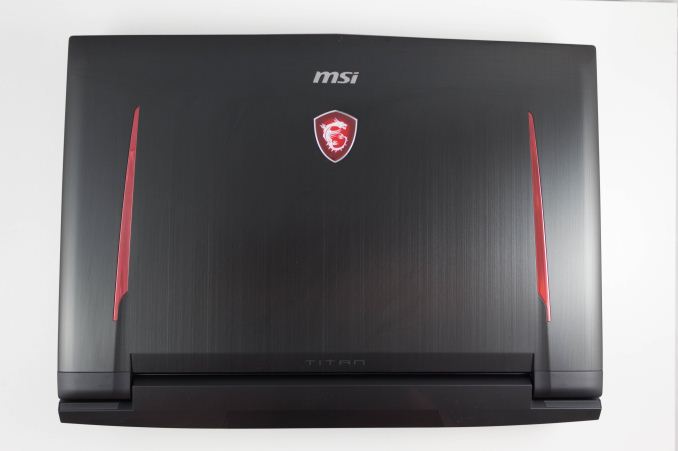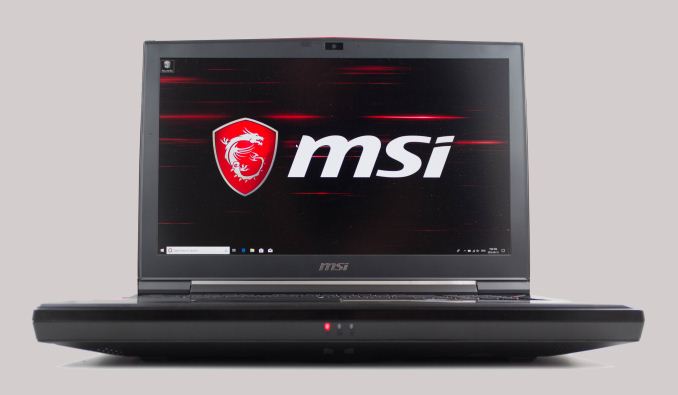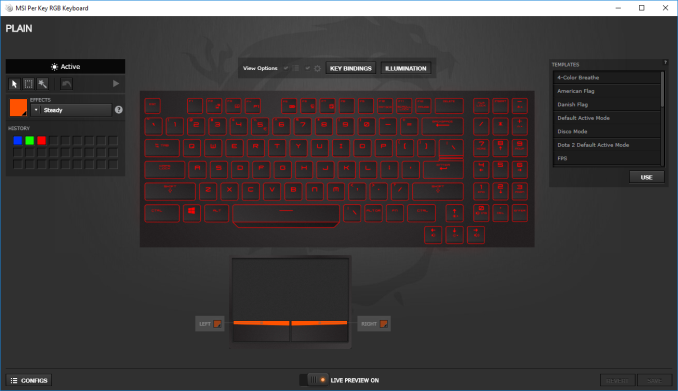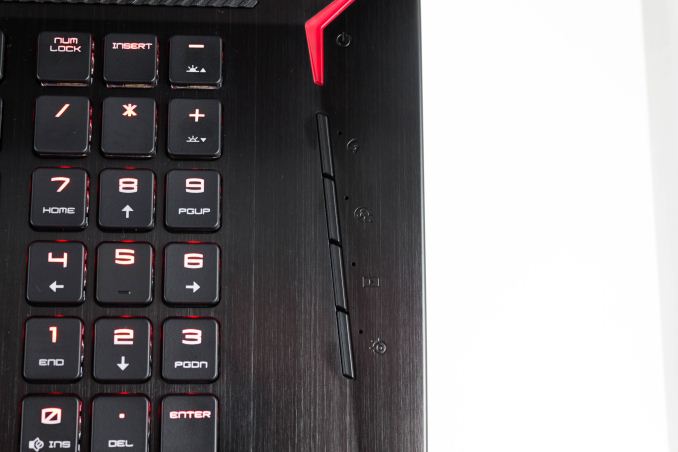The MSI GT75 Titan Laptop Review: Hex-Core DTR
by Brett Howse on September 13, 2018 9:00 AM EST- Posted in
- Laptops
- Gaming
- MSI
- Pascal
- Coffee Lake
- Coffee Lake-H
Design
MSI have a pretty recognizable aesthetic, and the GT75 Titan follows in that mold. As is normal with MSI, all the outside edges that you’d normally touch are capped with aluminum, but the bottom of the laptop you’ll never see is built out of plastic. There’s only one color option – Aluminum Black – and some tastefully placed LED lighting on the back of the display, and a red light on the keyboard deck which doubles as a power button.
We’ve moved to an era where you come to expect thin display bezels, but gaming laptops haven’t quite gotten there yet. On a 17.3-inch device like this, there’s easily room for the 18.4-inch display from the MSI GT83VR Titan which we reviewed last year, but MSI would be stuck in the same boat as they are with that device where they can only get a 1920x1080 60 Hz display. Shrinking the laptop dimensions to put smaller bezels on the 17.3-inch that’s in there now would remove room for cooling. So, for now at least, the GT75 Titan looks a bit like last year’s laptop.
The build quality of MSI gaming laptops tends to be pretty good, and the GT75 Titan doesn’t have any of the creaks or groans of some other gaming laptops on the market. Even though the device is over 10 lbs, there’s no flex at all in the chassis when picking it up on one end. MSI laptops always feel well built, and the GT75 Titan is not an exception.
Opening the laptop up, you can see one of the stars of the show. MSI has outfitted the GT75 with a SteelSeries mechanical keyboard, and it offers per-key RGB lighting. This keyboard is a treat to use, especially compared to some of the less expensive devices on the market. There’s a reason why mechanical keyboards are so popular. The feedback is wonderful, and although this doesn’t match a traditional desktop mechanical keyboard for key travel, there’s still plenty of travel available. MSI does offer the GT83VR Titan with a mechanical keyboard mounted at the front, and that device is much closer to a desktop, but in the normal laptop layout, the GT75 is probably one of the best around.
The per-key lighting isn’t just a gimmick either. MSI offers default modes to set the lighting for different gaming styles, so different key combinations are illuminated, or you can just choose your own preference and set it exactly how you would like it to be. MSI also has a nice trick when the function key is pressed. All other keys turn off except those that have a function available, so you can more quickly find the one you want. It sounds small, but it really is a nice feature.
If there were any quibbles about the keyboard, they would be relatively minor. The Fn key is in an odd location right of the space bar, compared to most laptops, although it can be swapped with the Windows Key in software. Also, the key pad, like most laptops, is a bit squished, but thankfully the arrow keys are well placed and full sized.
There’s also five buttons on the right side of the keyboard deck. The top one is the power button, Below that is a button to launch the MSI Dragon Center, which is their control panel to access all of the settings for the laptop. Next is the fan speed control, which toggles it between automatic and maximum fan. Second from the bottom is a button to launch XSplit Gamecaster, and the last button launches the SteelSeries software.
The track pad is generously sized, and offers a nice smooth surface for scrolling. It features physical buttons as well at the bottom, and there’s customizable lighting you can set for both the left and right buttons. The Synaptics touch pad works pretty well overall, but it does seem to have a tendency to sometimes register taps as a downward movement which can be annoying. If you use the mouse keys, that’s not an issue, but it was a bit frustrating to use the touch pad. On a gaming laptop, that’s a small annoyance though, since it’s most likely to be used with a mouse anyway.
The attention to detail on the keyboard deck also carries into the markings on the laptop, which are all etched into the aluminum, so they can’t rub off. It’s another small detail that works well.
On the sides and back is an almost ridiculous number of ports, with five USB 3.1 Gen 2 Type-A ports on the sides, along with the four 3.5 mm jacks for audio, an SD card reader, and a locking slot. On the rear is the Thunderbolt 3 USB-C port, along with both mini DisplayPort and HDMI 2.0, a five pin power connector, and the 10 Gigabit Ethernet jack.
The underside of the laptop is almost entirely covered in air vents for pulling in cool air, and there’s large exhaust ports on both the sides and the back. This is a big, thick, heavy laptop, but all of that cooling is important for what’s inside.


















48 Comments
View All Comments
ViRGE - Thursday, September 13, 2018 - link
Later on in the article, they mention that it's the new adapter based on Intel 9260, rather than the awful Qualcomm stuff. That may make it worth it. The worst part of Killer's stuff in recent years wasn't the software, it was the underlying hardware.Brett Howse - Thursday, September 13, 2018 - link
Yes the 1550 didn't exhibit any of the issues I've seen with the older model. I was pretty happy with it.PeachNCream - Friday, September 14, 2018 - link
In a roundabout way, this validates a number of complaints about earlier models of Killer Wireless products that were the subject of ire in previous articles. It's a shame that sort of acknowledgement wasn't around when previous generations were actually being sold. Also, this is the first time I've seen a Killer Wireless even get a bandwidth test in a while. Recent motherboards equipped with earlier model Killer WiFi cards didn't get any testing. I'm not trying to connect and conspiracy dots here, but the combination of facts doesn't paint a very rosy picture about the past couple years of Anandtech's view of Killer products and might add fuel to the fire of people like timecop1818 to continue to denounce Rivet Networks' claims as suspicious.Brett Howse - Friday, September 14, 2018 - link
You're mistaken I've reviewed plenty of laptops with Killer's previous model and every single time I said they had reliability issues. I think I've been pretty clear over the last couple of years that at this point there's Intel and no one else in terms of quality Wi-Fi. In fact I recently reviewed a laptop with the Qualcomm Wi-Fi that the Killer was based on and it had the exact same issues.PeachNCream - Friday, September 14, 2018 - link
That wasn't a call out of you in specific, but the tone of the site as a whole. In fact, I agree that you've noted stability problems and recommended driver updates in reviews of the Dell XPS 15 9560, the MSI GT83VR Titan 7RF, and Clevo P870DM2, and had a relatively slow result with a Razer Blade Stealth in March of 2016. (I didn't remember so I just checked and apologize for leaving you with the impression that I was slinging ire your way.)The lack of bandwidth testing is more a comment about motherboard reviews where there isn't much in the way of validation done with NIC performance, but there were some comments espousing the benefits of its presence. There have also been past product announcements that were promotional in nature. All of that was in the absence of analytical testing that proved the benefit of the Killer NIC's traffic prioritization, its key selling point. Mix that situation with the lingering ire Bigfoot/Rivet/whomever else has built over the years with customers and you've got a situation where people will get defensive or aggressive over being told they should find the product useful. None of that is something I think you've had a hand in. The problem is, or maybe was given the transition to Intel hardware and that the point is probably now moot, elsewhere.
pyrrh0 - Thursday, September 20, 2018 - link
I work with Wi-Fi and Apple's choice of Broadcom's kit in its laptops trumps anything I've used or heard about using Intel's WLAN gear.bennyg - Friday, September 14, 2018 - link
Eh, I had an issue a few years ago that was easily fixed by uninstalling the silly management software, killer wlan issues are overblown imoRedNeon - Friday, September 14, 2018 - link
Except that there already is a laptop with AMD Vega 56 GPU, the Acer Predator Helios 500.RedNeon - Friday, September 14, 2018 - link
Anandtech used to be good.Brett Howse - Friday, September 14, 2018 - link
Those were the days!